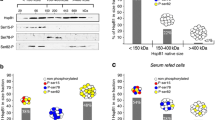Abstract
The holdase activity and oligomeric propensity of human small heat shock proteins (sHSPs) are regulated by environmental factors. However, atomic-level details are lacking for the mechanisms by which stressors alter sHSP responses. We previously demonstrated that regulation of HSPB5 is mediated by a single conserved histidine over a physiologically relevant pH range of 6.5–7.5. Here, we demonstrate that HSPB1 responds to pH via a similar mechanism through pH-dependent structural changes that are induced via protonation of the structurally analogous histidine. Results presented here show that acquisition of a positive charge, either by protonation of His124 or its substitution by lysine, reduces the stability of the dimer interface of the α-crystallin domain, increases oligomeric size, and modestly increases chaperone activity. Our results suggest a conserved mechanism of pH-dependent structural regulation among the human sHSPs that possess the conserved histidine, although the functional consequences of the structural modulations vary for different sHSPs.



Similar content being viewed by others
References
Almeida-Souza L, Goethals S, de Winter V, Dierick I, Gallardo R, Van Durme J, Irobi J, Gettemans J, Rousseau F, Schymkowitz J, Timmerman V, Janssens S (2010) Increased monomerization of mutant HSPB1 leads to protein hyperactivity in Charot-Marie-Tooth neuropathy. J Biol Chem 285:12778–12786
Asthana A, Bollapalli M, Tangirala R, Bakthisaran R, Rao CM (2014) Hsp27 suppressed the Cu2+-induced amyloidogenicity, redox activity, and cytotoxicity of α-synuclein by metal ion stripping. Free Radical Bio Med 72:176–190
Bagneris C, Bateman OA, Naylor CE, Cronin N, Boelens WC, Keep NH, Slingsby C (2009) Crystal structures of alpha-crystallin domain dimers of alphaB-crystallin and Hsp20. J Mol Biol 392:1242–1252
Baranova EV, Weeks SD, Beelen S, Bukach OV, Gusev NB, Strelkov SV (2011) Three-dimensional structure of α-crystallin domain dimers of human small heat shock proteins HSPB1 and HSPB6. J Mol Biol 411:110–122
Chernik IS, Panasenko OO, Li Y, Marston SB, Gusev NB (2004) pH-induced changes of the structure of small heat shock proteins with molecular mass 24/27 kDa (HspB1). Biochem Bioph Res Co 324:1199–1203
Datskevich PN, Nefedova VV, Sudnitsyna MV, Gusev NB (2012) Mutations of small heat shock proteins and human congenital diseases. Biochemistry-Moscow 77:1500–1514
Hayes D, Napoli V, Mazurkie A, Stafford WF, Graceffa P (2009) Phosphorylation dependence of Hsp27 multimeric size and chaperone function. J Biol Chem 284:18801–18807
Hochberg GKA, Ecroyd H, Liu C, Cox D, Cascio D, Sawaya M, Collier MP, Stroud J, Carver JA, Baldwin AJ, Robinson CV, Eisenberg DS, Benesch JL, Laganowsky A (2014) The structured core domain of αB-crystallin can prevent amyloid fibrillation and associated toxicity. P Natl Acad Sci USA 111:E1562–E1570
Jehle S, Rajagopal P, Bardiaux B, Markovic S, Kuhne R, Stout JR, Higman VA, Klevit RE, van Rossum BJ, Oschkinat H (2010) Solid-state NMR and SAXS studies provide a structural basis for the activation of αB-crystallin oligomers. Nat Struct Mol Biol 17:1037–1042
Jehle S, Vollmar BS, Bardiaux B, Dove KK, Rajagopal P, Gonen T, Oschkinat H, Klevit RE (2011) N-terminal domain of αB-crystallin provides a conformational switch for multimerization and structural heterogeneity. P Natl Acad Sci USA 108:6409–6414
Johnson BA (2004) Using NMRView to visualize and analyze the NMR spectra of macromolecules. Methods Mol Biol 278:313–352
Jovcevski B, Kelly MA, Rote AP, Berg T, Gastall HY, Benesch JLP, Aquilina JA, Ecroyd H (2015) Phosphomimics destabilize Hsp27 oligomeric assemblies and enhance chaperone activity. Cell Chem Biol 22:186–195
Laganowsky A, Benesch JL, Landau M, Ding L, Sawaya MR, Cascio D, Huang Q, Robinson CV, Horwitz J, Eisenberg D (2010) Crystal structures of truncated alphaA and alphaB crystallins reveal structural mechanisms of polydispersity important for eye lens function. Protein Sci 19:1031–1043
Lelj-Garolla B, Mauk AG (2006) Self-association and chaperone activity of Hsp27 are thermally activated. J Biol Chem 281:8169–8174
Mainz A, Bardiaux B, Kuppler F, Multhaup G, Felli IC, Pierattelli R, Reif B (2012) Structural and mechanistic implications of metal binding in the small heat-shock protein αB-crystallin. J Biol Chem 287:1128–1138
McVicar N, Li AX, Goncalves DF, Bellyou M, Meakin SO, Prado MA, Bartha R (2014) Quantitative tissue pH measurement during cerebral ischemia using amine and amide concentration-independent detection (AACID) with MRI. J Cerebr Blood F Met 34:690–698
Muranova LK, Weeks SD, Strelkov SV, Gusev NB (2015) Characterization of mutants of human small heat shock protein HspB1 carrying replacements in the N-terminal domain and associated with hereditary motor neuron diseases. PLoS One. doi:10.1371/journal.pone.0126248
Nefedova VV, Datskevich PN, Sudnitsyna MV, Strelkov SV, Gusev NB (2013a) Physio-chemical properties of R140G and K141Q mutants of human small heat shock protein HspB1 associated with hereditary peripheral neuropathies. Biochimie 95:1582–1592
Nefedova VV, Sudnitsyna MV, Strelkov SV, Gusev NB (2013b) Structure and properties of G84R and L99M mutants of human small heat shock protein HspB1 correlating with motor neuropathy. Arch Biochem Biophys 538:16–24
Rajagopal P, Liu Y, Shi L, Clouser AF, Klevit RE (2015a) Structure of the α-crystallin domain from the redox-sensitive chaperone, HSPB1. J Biomol NMR 63:223–228
Rajagopal P, Tse E, Borst AJ, Delbecq SP, Shi L, Southworth DR, Klevit RE (2015b) A conserved histidine modulates HSPB5 structure to trigger chaperone activity in response to stress-related acidosis. elife. doi:10.7554/eLife.07304
Shashidharamurthy R, Koteiche HA, Dong J, Mchaourab HS (2005) Mechanism of chaperone function in small heat shock proteins. J Biol Chem 280:5281–5289
Singh AK, Manns MP, Seidler U (2011) Cytoprotective effects of acidosis via heat shock protein HSP27 against the anticancer drug doxorubicin. Cell Mol Life Sci 68:1041–1051
Weeks SD, Baranova EV, Heirbaut M, Beelen S, Shkumatov AV, Gusev NB, Strelkov SV (2013) Molecular structure and dynamics of the dimeric human small heat shock protein HSPB6. J Struct Biol 185:342–354
Acknowledgements
This work was supported by NIH grant 1R01 EY017370 to REK. AFC is supported in part by NIH MBTG T32 GM008268 and the Hurd Fellowship in Biophysics from the UW School of Medicine.
Author information
Authors and Affiliations
Corresponding author
Rights and permissions
About this article
Cite this article
Clouser, A.F., Klevit, R.E. pH-dependent structural modulation is conserved in the human small heat shock protein HSBP1. Cell Stress and Chaperones 22, 569–575 (2017). https://doi.org/10.1007/s12192-017-0783-z
Received:
Revised:
Accepted:
Published:
Issue Date:
DOI: https://doi.org/10.1007/s12192-017-0783-z




